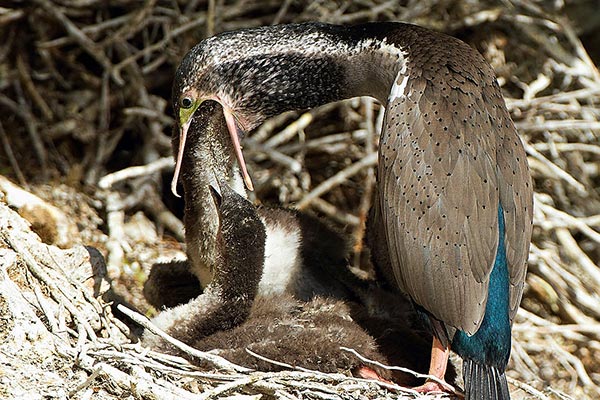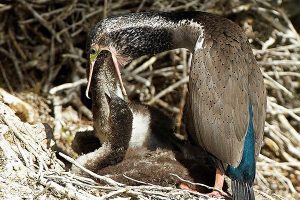Spotted Shag

Spotted Shag
Stictocarbo punctatus (Sparrman, 1786)
Order: Pelecaniformes
Family: Phalacrocoracidae
New Zealand status: Endemic
Conservation status: Not Threatened
Other names: spotted cormorant, parekareka, kawau tikitiki, blue shag (southern subspecies)
The spotted shag and closely related Pitt Island shag are the only yellow-footed shag species endemic to New Zealand. Adult spotted shags in breeding plumage are elegant and colourful, sporting a Mohican-like double crest, bright green-blue facial skin and blue eye rings. The species gets its name from the small black spots that appear near the tip of each back and wing covert feather during the breeding season. Spotted shags are entirely marine, breeding on the coasts of the North, South and Stewart Islands, and feeding in waters out to 16 km.
Outside the breeding season, spotted shags form large feeding and roosting flocks of up to 2000 birds.
A recent DNA study proposes placing spotted shag and Pitt Island shag in the genus Phalacrocorax rather than Stictocarbo, closest to pied shag, black-faced shag (P. fuscescens) and little black shag.
Identification
The spotted shag is a slim, medium-sized, grey-blue marine shag with a long, slender bill and yellow-orange feet. Adult breeding birds have small black spots on the pale silver-grey and brown back and wings, pale grey-blue underparts, and black thighs, rump and tail. A distinctive curved broad white stripe runs from above the eye down both sides of the neck, separating the black lines of the throat, pale silver-grey and brown back, and long neck to the base of the wing.
White filoplumes grow diagonally from the black neck and thighs, and a distinctive black, decurved, double crest grows erect on the forehead and nape. Bare facial skin between the eye and bill turns green-blue before the breeding season. The eye ring is blue, the iris dark brown. and the long, slender, hooked bill orange-brown. Non-breeding adults are duller, lack crests, have a neck stripe obscured by dark feathers, yellowish facial skin, and paler underparts.
Immatures are paler and browner, and lack distinct head or neck markings. In flight, spotted shags appear slender and pale with a darker rump and tail. The usually fly low over water, often in ‘V’ formation, using rapid wingbeats. Sexes are alike in plumage but males differ in their calls and courtship behaviour. The blue shag (S.p. oliveri) is darker with greenish-blue lower back, rump and flanks, with the white neck-stripe (in breeding plumage) not extending forward of the eye.
Voice: loud grunts at resting, roosting and nesting areas. Silent elsewhere.
Similar species: the spotted shag is the only slender, pale, greyish shag that occurs around the North, South and Stewart Islands. The closely-related Pitt Island shag takes the place of spotted shag at the Chattham Islands. Pitt Island shag is darker, lacks a neck stripe, and has a conspicuous purple patch in front of the eye. The ranges of Stewart Island shag and New Zealand king shag overlap with spotted shag, although they are darker and heavier with stockier necks, shorter wings and pink feet.

Distribution and habitat
Spotted shags occurs mainly around the South Island in coastal waters out to 16 km, entering inlets and estuaries to feed and roost. They are more localised on the west coast of the South Island, around Stewart Island, and parts of the North Island, including the Hauraki Gulf, West Auckland, Hawke’s Bay and Wellington Harbour. The strongholds for spotted shags are the Marlborough Sounds, Banks Peninsula and Otago coast. They are concentrated around breeding sites during summer, dispersing to other coastal areas in winter to form large flocks, usually within 200 km of the breeding grounds.
Population
Estimated total population of 10,000 to 50,000 breeding pairs with increases recorded around Banks Peninsula and Wellington Harbour over recent decades. A census conducted on Banks Peninsula during the 1996 breeding season found 22,123 breeding pairs, more than double the 1960 census which found 9,787 pairs. There is speculation the population was formerly limited by food availability and that a reduction in fishing effort around Banks Peninsula, especially in the late 1980s, may have contributed to the observed growth in the spotted shag breeding population.
Threats and conservation
The IUCN Red List and Department of Conservation classify the spotted shag as Not Threatened. Nests around Ashburton were systematically destroyed after the number of fishing huts increased there in the 1970s. Colonies at the Noises Islands in the Hauraki Gulf were reduced by illegal shooting in the 1980s, resulting in a localised decline. Some birds are caught accidentally and drown in fishing nets. See New Zealand fisheries by-catch information here.
Breeding
Spotted shags breed in colonies of a few pairs to 700 pairs. Timing varies year to year and in different parts of the range, depending on food availability. Peaks of laying recorded in Hauraki Gulf during March, August and December, at Matiu/Somes Island during June and November, at Banks Peninsula and Otago Harbour during September-November, and at Punakaiki during March-April and August-October. Hundreds of colonies are present throughout range. Spotted shags are monogamous; 3-4 pale blue eggs are laid in large nest platform made of sticks, iceplant and grass built 1 m apart on coastal cliff ledges and stacks. Incubation and chick-rearing are shared. Young leave the nest at 62 days. The oldest spotted shag recorded was over 10 years old.
Behaviour and ecology
Spotted shags dive from the sea surface to catch fish and marine invertebrates with their slender hooked bills, propelling themselves underwater with webbed feet. Outside the breeding season they form large feeding and roosting flocks of up to 2000 birds. Elaborate male display movements include wing-waving, swing-pointing, bowing, darting, sky-pointing, gaping, kink-throating, hopping, and various other body postures. Displaying males grunt; females are silent.
Food
Spotted shag diet consists of small fish and marine invertebrates, including squid and plankton. They feed in deep water up to 16 km offshore. Longest dive recorded was 70 seconds. Spotted shags often have a mass of small stones (‘rangle’) in the their gizzards, the function of which is debated, with possibilities including to function as ballast, to grind up food, and to create an inhospitable environment for gut parasites. Roosting birds often regurgitate piles of rangle stones that are obvious on sandy beaches but overlooked at rocky sites.

 Relax in the knowledge that you’ll be with the only NZ operator that guarantees you will not get seasick.
Relax in the knowledge that you’ll be with the only NZ operator that guarantees you will not get seasick.